Advanced Cropping Systems: Productivity and Sustainability Analysis
VerifiedAdded on 2023/06/04
|9
|2158
|467
Report
AI Summary
This report synthesizes key points from selected literature to discuss the development of sustainable cropping systems and the raising of productivity barriers in agriculture. It covers topics such as the stability of Australian grain supply chains, the economics of nitrogen application in farming systems, factors affecting sclerotinia stem rot in canola, the impact of crop rotations on root lesion nematodes and crown rot, optimizing canola yield in Western Australia considering frost and heat stress, and the influence of plant density and nitrogen on wheat cultivars. The report concludes that sustainable agriculture, including advanced cropping systems, is crucial for balancing productivity, profitability, and environmental health, while also addressing challenges in areas like grain supply chain efficiency and disease management.
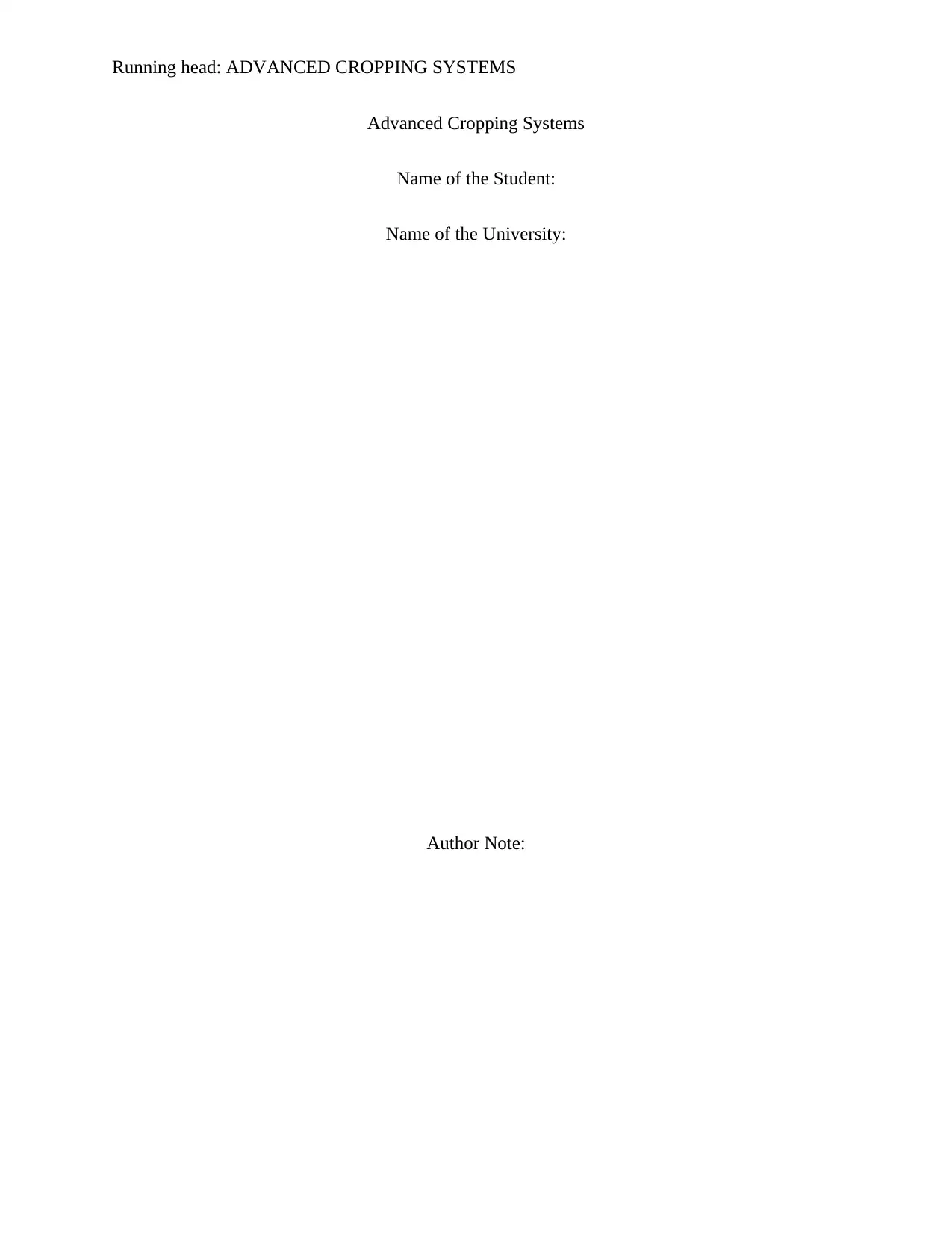
Running head: ADVANCED CROPPING SYSTEMS
Advanced Cropping Systems
Name of the Student:
Name of the University:
Author Note:
Advanced Cropping Systems
Name of the Student:
Name of the University:
Author Note:
Paraphrase This Document
Need a fresh take? Get an instant paraphrase of this document with our AI Paraphraser
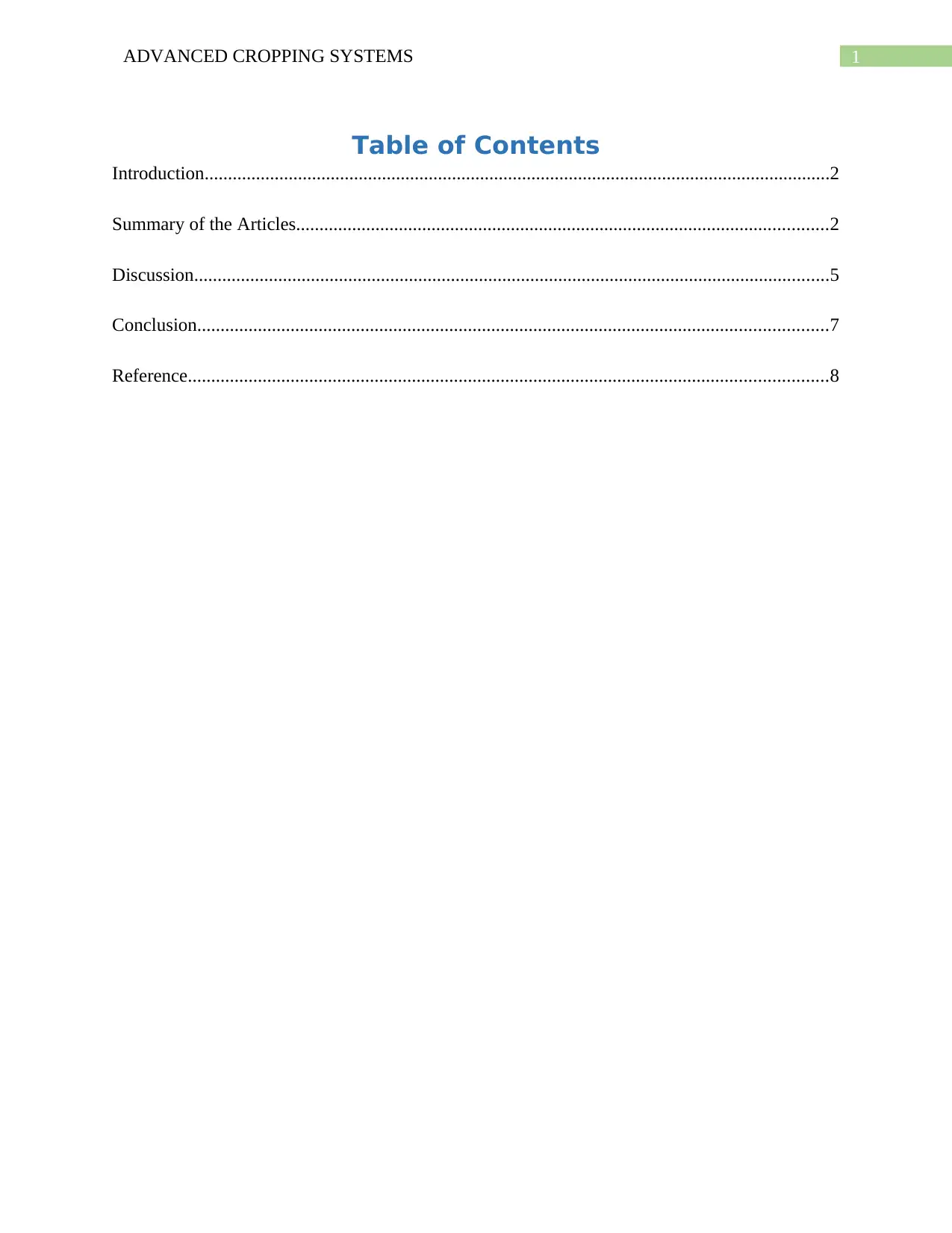
1ADVANCED CROPPING SYSTEMS
Table of Contents
Introduction......................................................................................................................................2
Summary of the Articles..................................................................................................................2
Discussion........................................................................................................................................5
Conclusion.......................................................................................................................................7
Reference.........................................................................................................................................8
Table of Contents
Introduction......................................................................................................................................2
Summary of the Articles..................................................................................................................2
Discussion........................................................................................................................................5
Conclusion.......................................................................................................................................7
Reference.........................................................................................................................................8
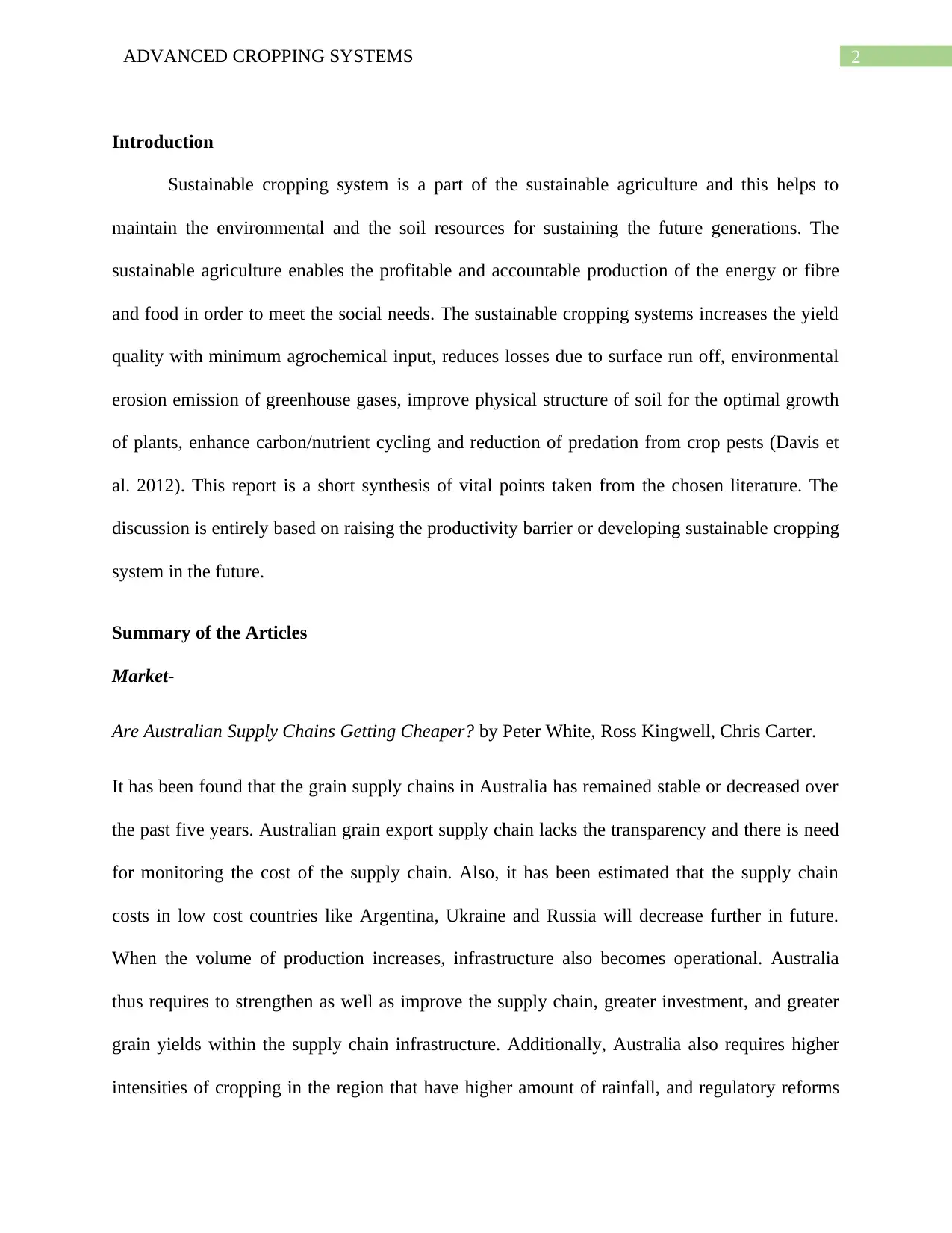
2ADVANCED CROPPING SYSTEMS
Introduction
Sustainable cropping system is a part of the sustainable agriculture and this helps to
maintain the environmental and the soil resources for sustaining the future generations. The
sustainable agriculture enables the profitable and accountable production of the energy or fibre
and food in order to meet the social needs. The sustainable cropping systems increases the yield
quality with minimum agrochemical input, reduces losses due to surface run off, environmental
erosion emission of greenhouse gases, improve physical structure of soil for the optimal growth
of plants, enhance carbon/nutrient cycling and reduction of predation from crop pests (Davis et
al. 2012). This report is a short synthesis of vital points taken from the chosen literature. The
discussion is entirely based on raising the productivity barrier or developing sustainable cropping
system in the future.
Summary of the Articles
Market-
Are Australian Supply Chains Getting Cheaper? by Peter White, Ross Kingwell, Chris Carter.
It has been found that the grain supply chains in Australia has remained stable or decreased over
the past five years. Australian grain export supply chain lacks the transparency and there is need
for monitoring the cost of the supply chain. Also, it has been estimated that the supply chain
costs in low cost countries like Argentina, Ukraine and Russia will decrease further in future.
When the volume of production increases, infrastructure also becomes operational. Australia
thus requires to strengthen as well as improve the supply chain, greater investment, and greater
grain yields within the supply chain infrastructure. Additionally, Australia also requires higher
intensities of cropping in the region that have higher amount of rainfall, and regulatory reforms
Introduction
Sustainable cropping system is a part of the sustainable agriculture and this helps to
maintain the environmental and the soil resources for sustaining the future generations. The
sustainable agriculture enables the profitable and accountable production of the energy or fibre
and food in order to meet the social needs. The sustainable cropping systems increases the yield
quality with minimum agrochemical input, reduces losses due to surface run off, environmental
erosion emission of greenhouse gases, improve physical structure of soil for the optimal growth
of plants, enhance carbon/nutrient cycling and reduction of predation from crop pests (Davis et
al. 2012). This report is a short synthesis of vital points taken from the chosen literature. The
discussion is entirely based on raising the productivity barrier or developing sustainable cropping
system in the future.
Summary of the Articles
Market-
Are Australian Supply Chains Getting Cheaper? by Peter White, Ross Kingwell, Chris Carter.
It has been found that the grain supply chains in Australia has remained stable or decreased over
the past five years. Australian grain export supply chain lacks the transparency and there is need
for monitoring the cost of the supply chain. Also, it has been estimated that the supply chain
costs in low cost countries like Argentina, Ukraine and Russia will decrease further in future.
When the volume of production increases, infrastructure also becomes operational. Australia
thus requires to strengthen as well as improve the supply chain, greater investment, and greater
grain yields within the supply chain infrastructure. Additionally, Australia also requires higher
intensities of cropping in the region that have higher amount of rainfall, and regulatory reforms
⊘ This is a preview!⊘
Do you want full access?
Subscribe today to unlock all pages.

Trusted by 1+ million students worldwide
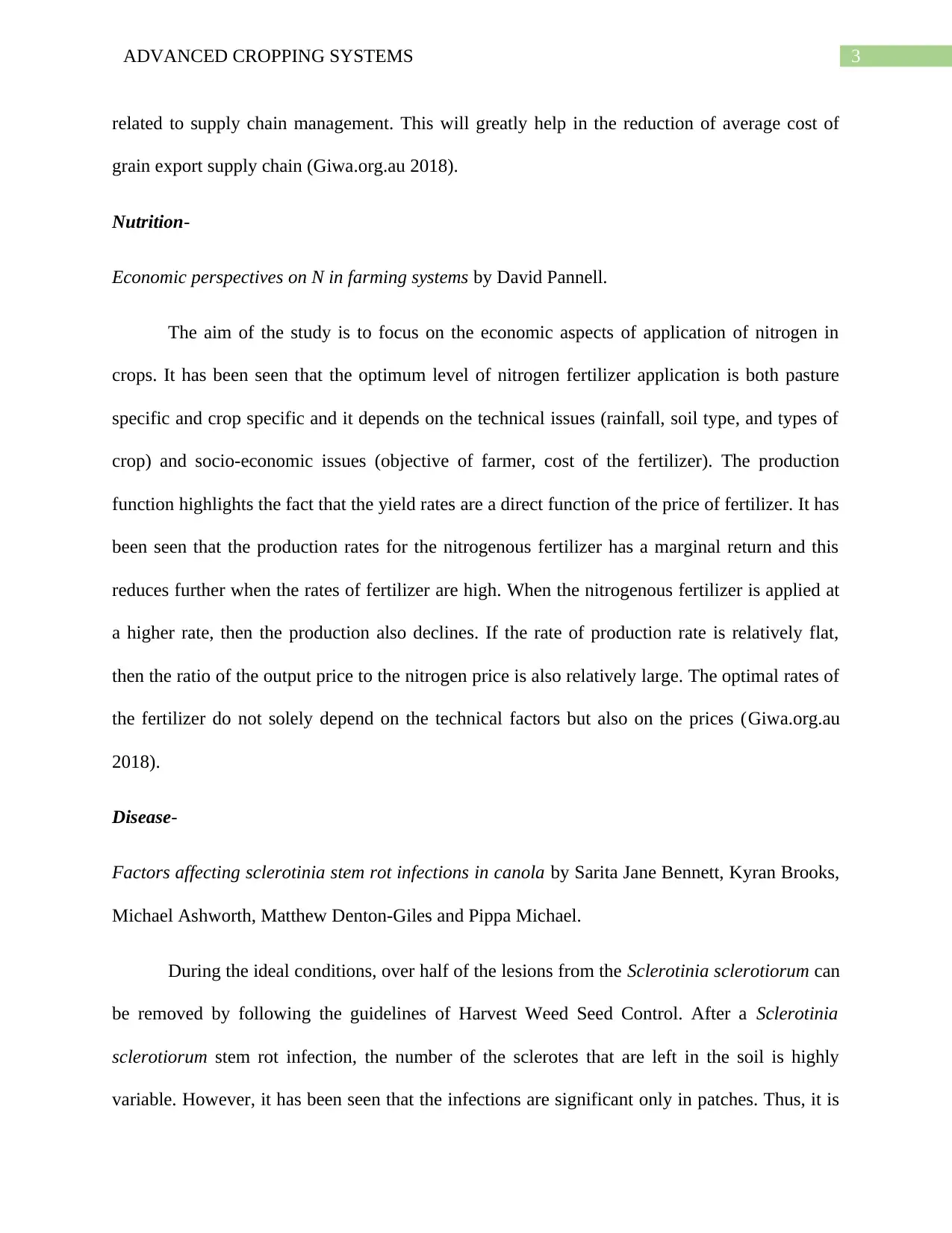
3ADVANCED CROPPING SYSTEMS
related to supply chain management. This will greatly help in the reduction of average cost of
grain export supply chain (Giwa.org.au 2018).
Nutrition-
Economic perspectives on N in farming systems by David Pannell.
The aim of the study is to focus on the economic aspects of application of nitrogen in
crops. It has been seen that the optimum level of nitrogen fertilizer application is both pasture
specific and crop specific and it depends on the technical issues (rainfall, soil type, and types of
crop) and socio-economic issues (objective of farmer, cost of the fertilizer). The production
function highlights the fact that the yield rates are a direct function of the price of fertilizer. It has
been seen that the production rates for the nitrogenous fertilizer has a marginal return and this
reduces further when the rates of fertilizer are high. When the nitrogenous fertilizer is applied at
a higher rate, then the production also declines. If the rate of production rate is relatively flat,
then the ratio of the output price to the nitrogen price is also relatively large. The optimal rates of
the fertilizer do not solely depend on the technical factors but also on the prices (Giwa.org.au
2018).
Disease-
Factors affecting sclerotinia stem rot infections in canola by Sarita Jane Bennett, Kyran Brooks,
Michael Ashworth, Matthew Denton-Giles and Pippa Michael.
During the ideal conditions, over half of the lesions from the Sclerotinia sclerotiorum can
be removed by following the guidelines of Harvest Weed Seed Control. After a Sclerotinia
sclerotiorum stem rot infection, the number of the sclerotes that are left in the soil is highly
variable. However, it has been seen that the infections are significant only in patches. Thus, it is
related to supply chain management. This will greatly help in the reduction of average cost of
grain export supply chain (Giwa.org.au 2018).
Nutrition-
Economic perspectives on N in farming systems by David Pannell.
The aim of the study is to focus on the economic aspects of application of nitrogen in
crops. It has been seen that the optimum level of nitrogen fertilizer application is both pasture
specific and crop specific and it depends on the technical issues (rainfall, soil type, and types of
crop) and socio-economic issues (objective of farmer, cost of the fertilizer). The production
function highlights the fact that the yield rates are a direct function of the price of fertilizer. It has
been seen that the production rates for the nitrogenous fertilizer has a marginal return and this
reduces further when the rates of fertilizer are high. When the nitrogenous fertilizer is applied at
a higher rate, then the production also declines. If the rate of production rate is relatively flat,
then the ratio of the output price to the nitrogen price is also relatively large. The optimal rates of
the fertilizer do not solely depend on the technical factors but also on the prices (Giwa.org.au
2018).
Disease-
Factors affecting sclerotinia stem rot infections in canola by Sarita Jane Bennett, Kyran Brooks,
Michael Ashworth, Matthew Denton-Giles and Pippa Michael.
During the ideal conditions, over half of the lesions from the Sclerotinia sclerotiorum can
be removed by following the guidelines of Harvest Weed Seed Control. After a Sclerotinia
sclerotiorum stem rot infection, the number of the sclerotes that are left in the soil is highly
variable. However, it has been seen that the infections are significant only in patches. Thus, it is
Paraphrase This Document
Need a fresh take? Get an instant paraphrase of this document with our AI Paraphraser
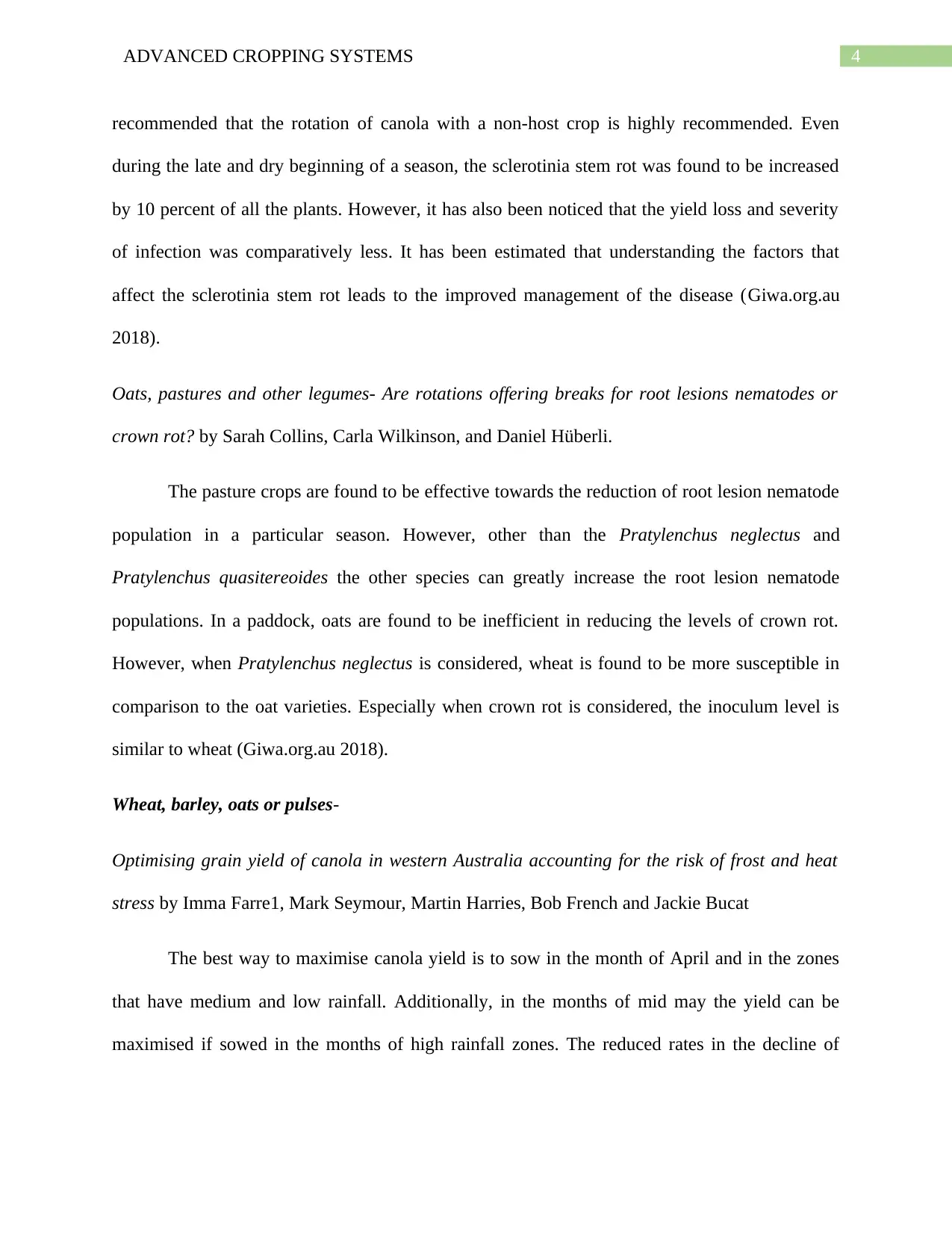
4ADVANCED CROPPING SYSTEMS
recommended that the rotation of canola with a non-host crop is highly recommended. Even
during the late and dry beginning of a season, the sclerotinia stem rot was found to be increased
by 10 percent of all the plants. However, it has also been noticed that the yield loss and severity
of infection was comparatively less. It has been estimated that understanding the factors that
affect the sclerotinia stem rot leads to the improved management of the disease (Giwa.org.au
2018).
Oats, pastures and other legumes- Are rotations offering breaks for root lesions nematodes or
crown rot? by Sarah Collins, Carla Wilkinson, and Daniel Hüberli.
The pasture crops are found to be effective towards the reduction of root lesion nematode
population in a particular season. However, other than the Pratylenchus neglectus and
Pratylenchus quasitereoides the other species can greatly increase the root lesion nematode
populations. In a paddock, oats are found to be inefficient in reducing the levels of crown rot.
However, when Pratylenchus neglectus is considered, wheat is found to be more susceptible in
comparison to the oat varieties. Especially when crown rot is considered, the inoculum level is
similar to wheat (Giwa.org.au 2018).
Wheat, barley, oats or pulses-
Optimising grain yield of canola in western Australia accounting for the risk of frost and heat
stress by Imma Farre1, Mark Seymour, Martin Harries, Bob French and Jackie Bucat
The best way to maximise canola yield is to sow in the month of April and in the zones
that have medium and low rainfall. Additionally, in the months of mid may the yield can be
maximised if sowed in the months of high rainfall zones. The reduced rates in the decline of
recommended that the rotation of canola with a non-host crop is highly recommended. Even
during the late and dry beginning of a season, the sclerotinia stem rot was found to be increased
by 10 percent of all the plants. However, it has also been noticed that the yield loss and severity
of infection was comparatively less. It has been estimated that understanding the factors that
affect the sclerotinia stem rot leads to the improved management of the disease (Giwa.org.au
2018).
Oats, pastures and other legumes- Are rotations offering breaks for root lesions nematodes or
crown rot? by Sarah Collins, Carla Wilkinson, and Daniel Hüberli.
The pasture crops are found to be effective towards the reduction of root lesion nematode
population in a particular season. However, other than the Pratylenchus neglectus and
Pratylenchus quasitereoides the other species can greatly increase the root lesion nematode
populations. In a paddock, oats are found to be inefficient in reducing the levels of crown rot.
However, when Pratylenchus neglectus is considered, wheat is found to be more susceptible in
comparison to the oat varieties. Especially when crown rot is considered, the inoculum level is
similar to wheat (Giwa.org.au 2018).
Wheat, barley, oats or pulses-
Optimising grain yield of canola in western Australia accounting for the risk of frost and heat
stress by Imma Farre1, Mark Seymour, Martin Harries, Bob French and Jackie Bucat
The best way to maximise canola yield is to sow in the month of April and in the zones
that have medium and low rainfall. Additionally, in the months of mid may the yield can be
maximised if sowed in the months of high rainfall zones. The reduced rates in the decline of

5ADVANCED CROPPING SYSTEMS
yield is to sow early so that the potential of the yield is high even during the risk from frost and it
depends on the location (Giwa.org.au 2018).
Plant density and nitrogen influences on wheat cultivars in western Australia by Christine
Zaicou-Kunesch1, Bob French, Brenda Shackley, Jeremy Curry and Dion Nicol.
The wheat cultivars within an environment having different plant density and different
nitrogen concentration in soil did not showed any response of higher yield. These trails were
conducted between the years of 2015 and 2016. Studies have shown that plant yield is low when
plant are sown in densities below 100 plants per m2. There is a lack of evidence of higher or
reduced yield when plants are sown in densities of 200 plants per m2. In comparison to density
and maturity, the maturity of the variety plays a major role in greater yield even when the site
experiences frost damage (Giwa.org.au 2018).
Discussion
Nitrogenous fertilizers are one of the best ways to compensate for the lack of nitrogen in
the soil but, there are risks associated with the improper application of nitrogenous fertilizers.
One of the major flaws is the output to the cost ratio. The cost of the nitrogenous fertilizer is
high, whereas the returns from the crop yield do not compensate the same. The optimal rate of
application of the nitrogenous fertilizer also tend to increase the risk associated with the crop
yield. Thus, crop rotation with a legume crop is the best way to reduce the increased dependence
on nitrogenous fertilizers. The legume rotations provide a wide array of benefits which includes
the proper weed management strategies, reduced incidence of crop diseases, diversified sources
of income. Additionally, there is the provision of atmospheric nitrogen fixation and good quality
livestock feed (Savci 2012).
yield is to sow early so that the potential of the yield is high even during the risk from frost and it
depends on the location (Giwa.org.au 2018).
Plant density and nitrogen influences on wheat cultivars in western Australia by Christine
Zaicou-Kunesch1, Bob French, Brenda Shackley, Jeremy Curry and Dion Nicol.
The wheat cultivars within an environment having different plant density and different
nitrogen concentration in soil did not showed any response of higher yield. These trails were
conducted between the years of 2015 and 2016. Studies have shown that plant yield is low when
plant are sown in densities below 100 plants per m2. There is a lack of evidence of higher or
reduced yield when plants are sown in densities of 200 plants per m2. In comparison to density
and maturity, the maturity of the variety plays a major role in greater yield even when the site
experiences frost damage (Giwa.org.au 2018).
Discussion
Nitrogenous fertilizers are one of the best ways to compensate for the lack of nitrogen in
the soil but, there are risks associated with the improper application of nitrogenous fertilizers.
One of the major flaws is the output to the cost ratio. The cost of the nitrogenous fertilizer is
high, whereas the returns from the crop yield do not compensate the same. The optimal rate of
application of the nitrogenous fertilizer also tend to increase the risk associated with the crop
yield. Thus, crop rotation with a legume crop is the best way to reduce the increased dependence
on nitrogenous fertilizers. The legume rotations provide a wide array of benefits which includes
the proper weed management strategies, reduced incidence of crop diseases, diversified sources
of income. Additionally, there is the provision of atmospheric nitrogen fixation and good quality
livestock feed (Savci 2012).
⊘ This is a preview!⊘
Do you want full access?
Subscribe today to unlock all pages.

Trusted by 1+ million students worldwide

6ADVANCED CROPPING SYSTEMS
The western regions of Australia have experienced that crop rotation is actually beneficial
in increasing the resistance of the wheat crops towards the common pests and the associated
diseases. Serradella pastures can be used as a cleaning phase of the root lesion nodules and along
with the introduction of nitrogen into soil. To decrease the incidence of root lesion nodule
infection, the crop rotation with oat varieties reduces the pest infections and disease incidence.
The oat varieties are highly resistant to the P.neglectus and are better in resistance in comparison
to a majority of the wheat varieties (Thompson, Zwart and Butler 2012). In the canola
cultivation, sclerotinia infection of the stem rot varies to great extent in different seasons. In
comparison to the wet seasons, dry season is comparatively the best season for the cultivation of
canola due to the reduced incidence of sclerotinia infections (Barbetti et al. 2014).
The optimum period for the sowing of canola depends on the type of the cultivar and the
location of cultivation. The sustainable cropping practices that promote high yields is the rainy
season where the rainfall varies from mid to low intensities. The beginning to the end of the
month of April best suites the cropping pattern. Sowing later increases the risk from frost and
thus sowing window plays a major role in increasing the crop yield. Adding nitrogenous
fertilizer externally to the wheat cultivation did not yielded as per the desired outcomes. Along
with this the plant density of 100 to 200 plants per m2 is found to be ineffective in increasing the
yield (Mohammadi and Rokhzadi 2012).
The cost of the grain export supply chain is high due to the varying costs occurring due to
spatial and temporal changes. The export grain supply chain cost can be brought down with
larger emphasis on the improvement of operations, investment in infrastructure, improvement in
the crop yields, intensified cropping in the areas of high rainfall, and regulatory reforms. This
The western regions of Australia have experienced that crop rotation is actually beneficial
in increasing the resistance of the wheat crops towards the common pests and the associated
diseases. Serradella pastures can be used as a cleaning phase of the root lesion nodules and along
with the introduction of nitrogen into soil. To decrease the incidence of root lesion nodule
infection, the crop rotation with oat varieties reduces the pest infections and disease incidence.
The oat varieties are highly resistant to the P.neglectus and are better in resistance in comparison
to a majority of the wheat varieties (Thompson, Zwart and Butler 2012). In the canola
cultivation, sclerotinia infection of the stem rot varies to great extent in different seasons. In
comparison to the wet seasons, dry season is comparatively the best season for the cultivation of
canola due to the reduced incidence of sclerotinia infections (Barbetti et al. 2014).
The optimum period for the sowing of canola depends on the type of the cultivar and the
location of cultivation. The sustainable cropping practices that promote high yields is the rainy
season where the rainfall varies from mid to low intensities. The beginning to the end of the
month of April best suites the cropping pattern. Sowing later increases the risk from frost and
thus sowing window plays a major role in increasing the crop yield. Adding nitrogenous
fertilizer externally to the wheat cultivation did not yielded as per the desired outcomes. Along
with this the plant density of 100 to 200 plants per m2 is found to be ineffective in increasing the
yield (Mohammadi and Rokhzadi 2012).
The cost of the grain export supply chain is high due to the varying costs occurring due to
spatial and temporal changes. The export grain supply chain cost can be brought down with
larger emphasis on the improvement of operations, investment in infrastructure, improvement in
the crop yields, intensified cropping in the areas of high rainfall, and regulatory reforms. This
Paraphrase This Document
Need a fresh take? Get an instant paraphrase of this document with our AI Paraphraser
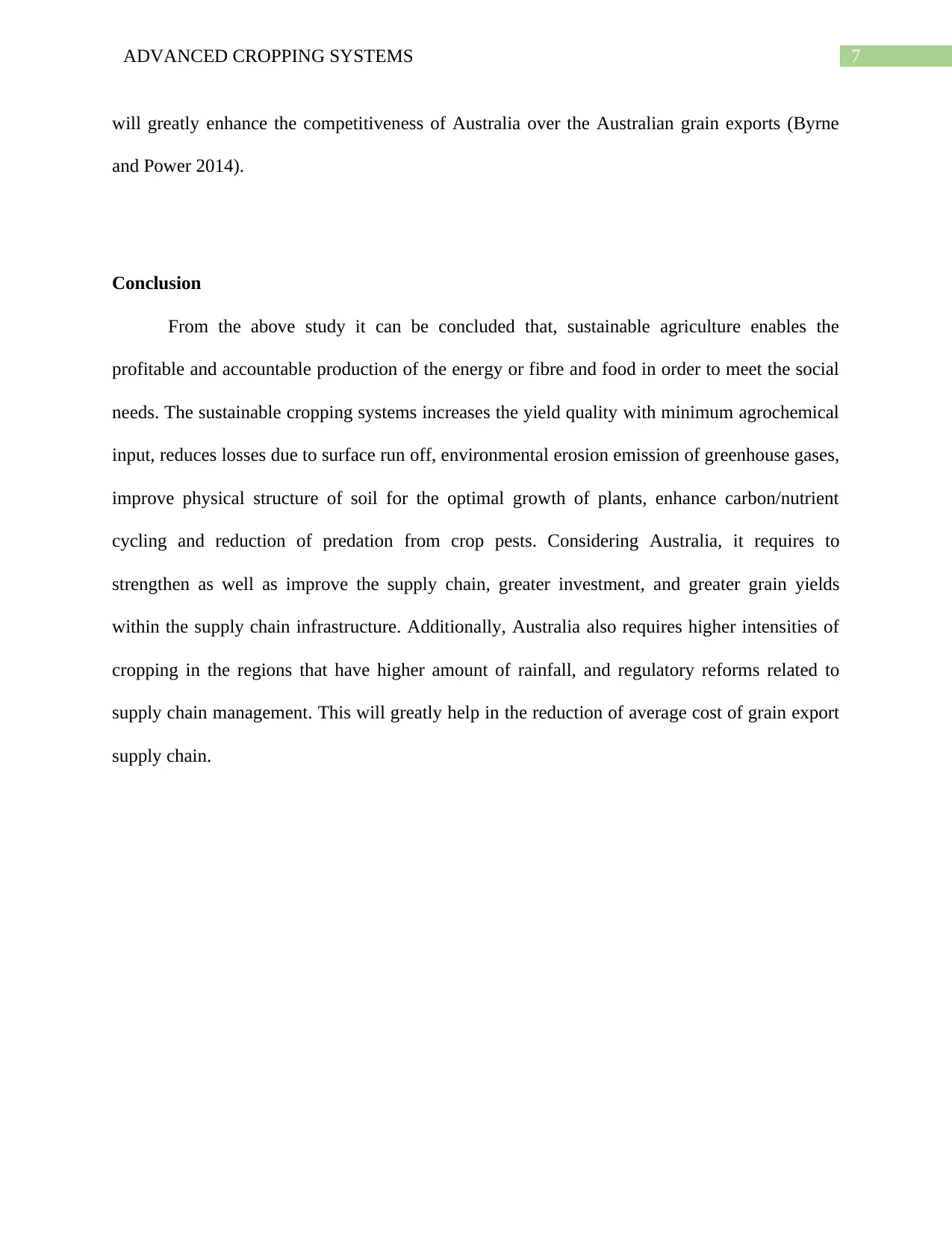
7ADVANCED CROPPING SYSTEMS
will greatly enhance the competitiveness of Australia over the Australian grain exports (Byrne
and Power 2014).
Conclusion
From the above study it can be concluded that, sustainable agriculture enables the
profitable and accountable production of the energy or fibre and food in order to meet the social
needs. The sustainable cropping systems increases the yield quality with minimum agrochemical
input, reduces losses due to surface run off, environmental erosion emission of greenhouse gases,
improve physical structure of soil for the optimal growth of plants, enhance carbon/nutrient
cycling and reduction of predation from crop pests. Considering Australia, it requires to
strengthen as well as improve the supply chain, greater investment, and greater grain yields
within the supply chain infrastructure. Additionally, Australia also requires higher intensities of
cropping in the regions that have higher amount of rainfall, and regulatory reforms related to
supply chain management. This will greatly help in the reduction of average cost of grain export
supply chain.
will greatly enhance the competitiveness of Australia over the Australian grain exports (Byrne
and Power 2014).
Conclusion
From the above study it can be concluded that, sustainable agriculture enables the
profitable and accountable production of the energy or fibre and food in order to meet the social
needs. The sustainable cropping systems increases the yield quality with minimum agrochemical
input, reduces losses due to surface run off, environmental erosion emission of greenhouse gases,
improve physical structure of soil for the optimal growth of plants, enhance carbon/nutrient
cycling and reduction of predation from crop pests. Considering Australia, it requires to
strengthen as well as improve the supply chain, greater investment, and greater grain yields
within the supply chain infrastructure. Additionally, Australia also requires higher intensities of
cropping in the regions that have higher amount of rainfall, and regulatory reforms related to
supply chain management. This will greatly help in the reduction of average cost of grain export
supply chain.

8ADVANCED CROPPING SYSTEMS
Reference
Barbetti, M. J., S. K. Banga, T. D. Fu, Y. C. Li, D. Singh, S. Y. Liu, X. T. Ge, and S. S. Banga.
"Comparative genotype reactions to Sclerotinia sclerotiorum within breeding populations of
Brassica napus and B. juncea from India and China." Euphytica 197, no. 1 (2014): 47-59.
Byrne, Romona, and Damien Power. "Exploring agency, knowledge and power in an Australian
bulk cereal supply chain: a case study." Supply Chain Management: An International Journal 19,
no. 4 (2014): 431-444.
Davis, Adam S., Jason D. Hill, Craig A. Chase, Ann M. Johanns, and Matt Liebman. "Increasing
cropping system diversity balances productivity, profitability and environmental health." PloS
one 7, no. 10 (2012): e47149.
Giwa.org.au. 2018. "2018 Research Updates". Giwa.Org.Au.
http://www.giwa.org.au/2018researchupdates.
Mohammadi, Khosro, and Asad Rokhzadi. "An integrated fertilization system of canola
(Brassica napus L.) production under different crop rotations." Industrial Crops and Products37,
no. 1 (2012): 264-269.
Savci, Serpil. "An agricultural pollutant: chemical fertilizer." International Journal of
Environmental Science and Development 3, no. 1 (2012): 73.
Thompson, John P., Rebecca S. Zwart, and David Butler. "Inheritance of resistance to root-lesion
nematodes (Pratylenchus thornei and P. neglectus) in five doubled-haploid populations of
wheat." Euphytica 188, no. 2 (2012): 209-219.
Reference
Barbetti, M. J., S. K. Banga, T. D. Fu, Y. C. Li, D. Singh, S. Y. Liu, X. T. Ge, and S. S. Banga.
"Comparative genotype reactions to Sclerotinia sclerotiorum within breeding populations of
Brassica napus and B. juncea from India and China." Euphytica 197, no. 1 (2014): 47-59.
Byrne, Romona, and Damien Power. "Exploring agency, knowledge and power in an Australian
bulk cereal supply chain: a case study." Supply Chain Management: An International Journal 19,
no. 4 (2014): 431-444.
Davis, Adam S., Jason D. Hill, Craig A. Chase, Ann M. Johanns, and Matt Liebman. "Increasing
cropping system diversity balances productivity, profitability and environmental health." PloS
one 7, no. 10 (2012): e47149.
Giwa.org.au. 2018. "2018 Research Updates". Giwa.Org.Au.
http://www.giwa.org.au/2018researchupdates.
Mohammadi, Khosro, and Asad Rokhzadi. "An integrated fertilization system of canola
(Brassica napus L.) production under different crop rotations." Industrial Crops and Products37,
no. 1 (2012): 264-269.
Savci, Serpil. "An agricultural pollutant: chemical fertilizer." International Journal of
Environmental Science and Development 3, no. 1 (2012): 73.
Thompson, John P., Rebecca S. Zwart, and David Butler. "Inheritance of resistance to root-lesion
nematodes (Pratylenchus thornei and P. neglectus) in five doubled-haploid populations of
wheat." Euphytica 188, no. 2 (2012): 209-219.
⊘ This is a preview!⊘
Do you want full access?
Subscribe today to unlock all pages.

Trusted by 1+ million students worldwide
1 out of 9
Related Documents
Your All-in-One AI-Powered Toolkit for Academic Success.
+13062052269
info@desklib.com
Available 24*7 on WhatsApp / Email
![[object Object]](/_next/static/media/star-bottom.7253800d.svg)
Unlock your academic potential
Copyright © 2020–2025 A2Z Services. All Rights Reserved. Developed and managed by ZUCOL.




